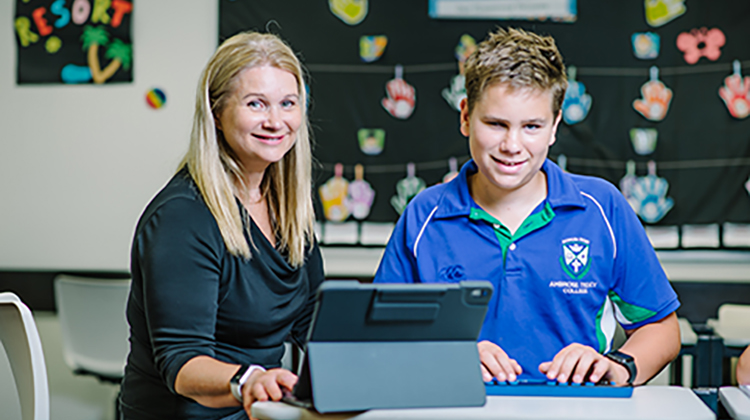Building a curriculum that includes students with vision impairment

The first national curriculum for students with a vision impairment could be rolled out in schools across Australia soon with trials taking place in schools later this year.
University of Southern Queensland (USQ) inclusive education researcher Melissa Fanshawe is helping build momentum, supported by Vision Australia and the South Pacific Educators in Vision Impairment.
Fanshawe, who has a 13-year-old son with a rare genetic vision impairment, has spent the past seven years researching ways to improve the mainstream schooling experience for students with a vision impairment.
About 3000 school-aged children in Australia have a vision impairment – 300 of which have a severe vision impairment or are blind – but these students are generally educated in mainstream schools, sometimes with little support.
“Schools and classrooms are built for students who can see, but unfortunately not all schools are aware of simple measures that can be adopted to meet the needs of students with a vision impairment,” said Fanshawe, a former principal who has worked closely with many blind and low vision students.
“Technology has made it easier for these students to learn, but things take longer to access for students who use braille and assistive technologies, and they are expected to do this and complete their tasks in the same amount of time.”
Fanshawe believed students with a vision impairment need to be exposed to the Expanded Core Curriculum (ECC), which requires explicit teaching to students with vision impairment to compensate for skills sighted peers gain incidentally by observing others and their environment.
She said although the ECC was first developed in 1996, it doesn’t get the attention it deserved because of factors such as time constraints and a lack of understanding from schools, teachers and families.
“Research shows that older adults who have been explicitly taught skills of the ECC experience positive career and life outcomes,” she said.
“A standardised national curriculum that centres on the ECC and the unique needs of students with no or low vision will enable schools and teachers to be aware of adjustments that can be easily made to access the curriculum.”
Fanshawe said the new curriculum would also give students with a vision impairment the opportunity to learn the ECC so they had a clear understanding of their goals and a greater scope for developing skills that are necessary for tertiary education and employment.
“The goal is to empower students to take an active role in their education and have more independence,” she said.
“Students would also feel a sense of belonging at school, which is paramount to positive education outcomes for students with vision impairment and is critical to their social and cognitive development.”
Vision Australia CEO Ron Hooton said parents of children with a vison impairment have long been calling for more support for their children in classrooms.
“Full implementation of the Expanded Core Curriculum is an essential part of ensuring the best possible education for children, leading to greater employment opportunities in later life,” Hooton said.
“Vision Australia is delighted to be working with Ms Fanshawe over the coming years to support this important project.”
Fanshawe said trials for the new curriculum could start as soon as July and hoped it would be accredited and rolled out in schools across Australia by 2022.
If you are interested in being involved, or would like more information about the project, contact Melissa Fanshawe at [email protected]
The nine areas of the Expanded Core Curriculum
- Assistive Technology
- Career Education
- Orientation and Mobility
- Compensatory Skills
- Independent Living Skills
- Recreation and Leisure
- Self-Determination
- Sensory Efficiency
- Social Interaction Skills